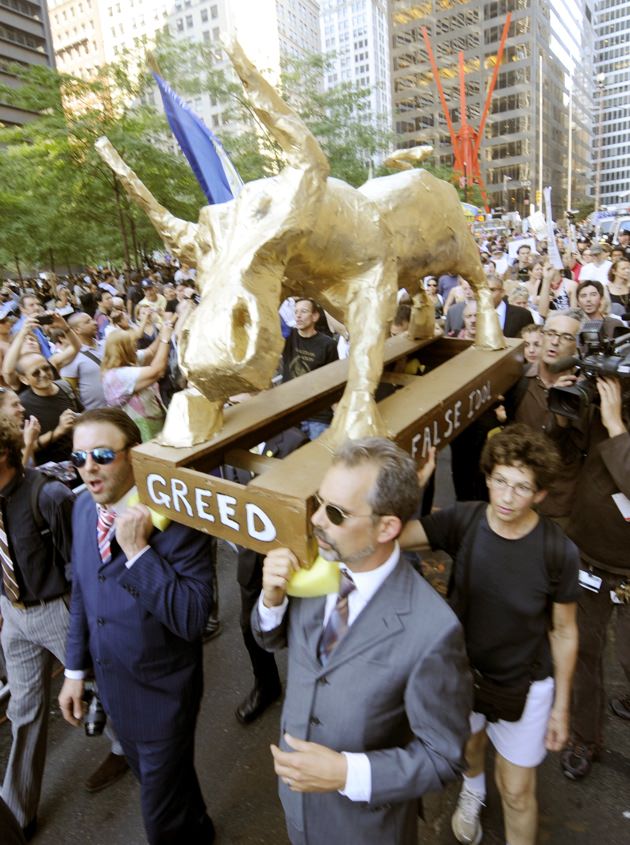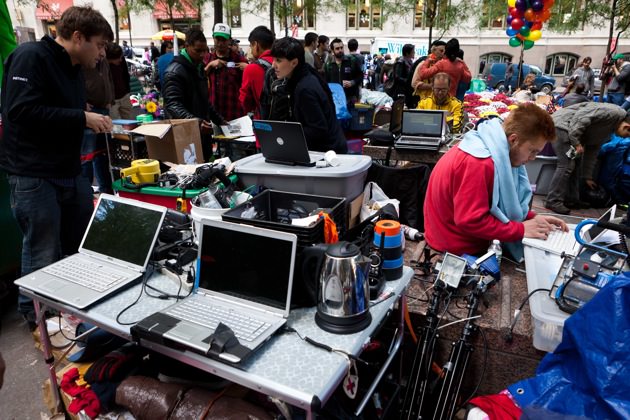Entering Zuccotti Park on October 4, a Tuesday, I felt as if I had walked into an impromptu forum. The park itself, which was renovated in 2006, is rather festive with its locust trees, its areas of planted mums, and, near the southeast corner, an anodyne red sculpture by Mark di Suvero entitled “Joie de Vivre” that rises seventy feet into the air. The Occupy Wall Street encampment was surprisingly well organized, with a “People’s Library” with plastic bins containing the kind of books you would find in a middle-class beach house. There was a phone-charging station, a medical area, a kitchen, and, along the southern wall of the park, a sleeping zone clumped with blankets, sleeping bags, rain tarps, and various personal belongings. A group of young men swept up refuse and put it in garbage bags.
Spontaneous debates broke out among the constantly forming and dissolving clusters of people—about home schooling, vegetarianism, racial profiling on the part of taxi drivers who are racially profiled themselves. Microphones and cameras were thrust forward without warning, belonging to members of the press or demonstrators, one couldn’t always tell. As often as not they came from a core group of protesters who were live-streaming the activities in the park on Global Revolution. Their command post (though they would strongly reject the phrase) comprised the inviolable hub of the encampment: the computer equipment was guarded unthreateningly by the people’s security force who stood ready to form a protective phalanx around the area should trouble arise.
The mood was expectant, spirits generally high, though not without a dampening note of ambivalence. Several of New York’s most important unions—including that of health care workers, teachers, transit workers, and communications workers—had organized a march to Foley Square for the following day in support of the protesters. The significance of these endorsements was enormous, conferring on the movement an instant legitimacy that many of its most seasoned members had not expected and some had not wanted at all. Several protesters anxiously told me of their determination “to keep the process pure” in the face of the new outside pressures. “Horizontal, autonomous, leaderless, modified—consensus-based” democracy was still in a delicate, experimental phase. (So said an article, “Occupation for Dummies,” by Nathan Schneider in the movement’s broadsheet paper, The Occupied Wall Street Journal, whose initial print run of 50,000 was paid for by a campaign on Kickstarter.)
It was impossible, of course, not to be swept up in the explosive rapidity of events. And there was little time to adjust to them. By the weekend of October 8, the tenor of the press coverage of the protest had become noticeably more respectful. And the protesters themselves, living for weeks in an inhospitable city park and withstanding police abuse in the name of ending corporate excess, had taken on to some of the public an aura of heroic innocence. There was no graffiti anywhere, only handmade signs. In my time in the park, I didn’t see any drugs or alcohol, except for a man discreetly drinking beer from a plastic gallon milk jug.
Seeing me take notes, a tall, elegant, rather knowing man who looked to be in his late forties approached me. He surprised me by introducing himself with his full name—Bill Dobbs. (His e-mail address was “duchamp,” a clue to his mindset.) He told me he had been an AIDS activist in the late 1980s, and for Occupy Wall Street he was involved in “outreach to the press.” When I asked him to characterize the protest, he answered, “It’s an outcry, pure and simple, an outcry that has cut through miles of cynicism.” He seemed unexcited about the union support and particularly scornful of the Democratic Party, elements of which were currently courting the movement. Paraphrasing Gore Vidal, he said, “There is only one party in the United States, the Property Party, and it has two right wings, Republicans and Democrats.” How, with this view, he expected to get people into positions of power he did not say.
At 7:30 PM, near the people’s library, the General Assembly convened. There were about five hundred of us and, as far as I could tell, we were all members for as long as we hung around. From their perch atop the wall on the northeast section of the park, two young women moderated the meeting. “Mike check!” one of the women cried, and with a unison roar the crowd repeated her words. This was “the people’s mike,” used in lieu of bullhorns, megaphones, or other amplification devices that were prohibited because the protesters had no permit. When the crowd has to repeat every word, it shows; for example, during a speech by the Nobel Prize economist Joseph Stiglitz, things slowed down. But in the large crowd the repetition created a kind of euphoria of camaraderie. It also put you in the oddly disturbing position at times of shouting at full voice something you neither agreed with nor would ever have thought on your own.
Advertisement
On the agenda was the march to Foley Square the next day, but first the moderators wanted to know “if there are any concerns about our process.” For newcomers, the process is patiently explained, each phrase shouted back at the speaker as if to cheer her on. Anyone can submit a proposal to the General Assembly. To pass it must have 90 percent support judged by a show of hands, at which point it may be published online or in The Occupied Wall Street Journal. We are coached in the hand gestures that are the silent coded language of the protest. If you raised your hands over your head and wiggled your fingers like a partygoer in a group dance, it meant you agreed with what had just been said. Other gestures conveyed ambivalence, disagreement, and finally the blocking signal—a severe locking of forearms that, we were instructed, should be used only if you had “serious ethical concerns” with what was being proposed.
Speakers came and went, the unsynchronized human microphones throwing back the words in garbled waves. Stuart Applebaum, head of the retail workers union, expressed his support with the air of a man paying tribute to an ally he was not sure he trusted or understood. His statement was brief and he rushed out of the park. A young man asked if acts of civil disobedience were planned for tomorrow’s march and was met with a hard silence. After a pause, a woman with a red bandana hiding her face said, “We are too smart to take the bait and answer this. Don’t give the NYPD what they want.”
At Foley Square the next day, the unions delivered what they had promised: a large-scale demonstration denouncing corporate malfeasance. We were corralled into the square and gazed out at the police walking along the wide empty street, as if we were watching them on a stage. After a short conversation, a man handed me a sign: “Minor Literary Celebrities for Economic Equality.” A woman complained that there had been no leaflets advertising the march in her neighborhood on the Upper West Side. “Where’s the outreach, for crying out loud.” I ducked into a bar with a group of Verizon workers who had nothing but good things to say about “those terrific kids in the park.”
At dusk on October 5, people were pouring into Zuccotti Park, drums pounding. The protest had reached its apotheosis. A girl sat on a sleeping bag feeding trail mix to a squirrel with a rope tied around its neck. A Billy Graham impersonator mock-preached into a megaphone, apparently unaware of the no-amplification rule. Two men held up a sheet projecting the movement’s Facebook page where the number of messages of support ticked higher by the second: 24,842 and rising. Cameras were everywhere—recording, broadcasting, feeding—and the people at the computer hub were hard at work, streaming it all live. The filmmaker Michael Moore arrived (it was the third time I had seen him in the park in two days), standing near the di Suvero sculpture, his face lit up in what seemed to be a state of ecstasy. “This movement has come together. Not because of a douchebag organization, but because the people wanted it. Let’s keep it like this. Do not let the politician co-opt you!”
Protesters compared notes on the New York jails they had been in, sharing the latest rumors about Tony Bologna, the deputy inspector who pepper sprayed three girls during a march on September 24, accelerating the movement’s rise. News that Steve Jobs had died circulated. He was the rare one-percenter whose demise provoked a moment of sadness in the park, no matter that Apple had recently surpassed Exxon as the American company with the highest market value.
A handful of protesters scuttled out of the park and headed toward the Stock Exchange on Wall Street. By 8:30 PM, hundreds of police had arrived, setting gray metal barricades along the Broadway entrance to the park, squeezing the crowd back inside. The protesters pressed against the metal gates, some wanting to dare the police and charge out toward the Stock Exchange, that mythic fortress two blocks away in the dark. In a panicked voice, a woman attempted to find a consensus, using the General Assembly procedure, opening debate on whether they should cross the line. “We can’t let ourselves turn into a mob!” she shouted. The face-off ended mildly, with twenty-three arrests; an hour later the park had thinned out and most of the police had dispersed. Remarkably, the mums had not been trampled.
Advertisement
It’s impossible to predict what will happen to the movement. It seems a delicate, almost ethereal process, designed for small groups, though new General Assemblies are constantly being established—as of October 9, protests had spread to 150 cities. Protestors are continually coming up with new ways to get their anti-corporate message across: on Sunday, a group of clergymen paraded through Zuccotti Park with a giant papier-mâché effigy of the biblical golden calf, modified to resemble the famous statue of the charging Wall Street bull. On Tuesday, they planned a march to billionaires’ homes on the Upper East Side. For now, the police are reluctant to crack down on a group that, incongruously, has won expressions of sympathy from President Obama, Ben Bernanke, and Nancy Pelosi.
Anne-Marie Slaughter, the well-known Princeton professor of international affairs, writing in The New York Times, points out that from the first days of Occupy Wall Street news outlets in the Middle East paid close attention. Referring to the Tunisian vendor whose self-immolation set off the Arab Spring, she writes,
Go to the Web site “We Are the 99 percent” and you will see the Mohamed Bouazizs of the United States, page after page of testimonials from members of the middle class who took out mortgages to pay for education, took out mortgages to buy their houses…worked hard at the jobs they could find, and ended up…on the precipice of financial and social ruin.
The protesters in Zuccotti Park seem to have heralded the membership of a significant portion of our population into a new form of Third World, a development that our media and government appear to have been the last to absorb.




